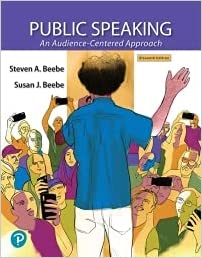(eBook PDF) Public Speaking: An Audience-Centered Approach 11th edition
$50.00 Original price was: $50.00.$35.00Current price is: $35.00.
(eBook PDF) Public Speaking: An Audience-Centered Approach 11th edition – Instant Download
SKU: EB-78108
Categories: Ebook-PDF, Social Science
Tags: Audience-Centered Approach, Public Speaking, Steven A. Beebe, Susan J Beebe
(eBook PDF) Public Speaking: An Audience-Centered Approach 11th edition – Digital Ebook – Instant Delivery Download

product details:
- ISBN-10 : 0135709717
- ISBN-13 : 978-0135709719
- Author: Steven A. Beebe, Susan J. Beebe
table of contents:
- Speaking With Confidence
- 1.1 What is Public Speaking?
- 1.2 Why Study Public Speaking?
- 1.3 The Rich Heritage of Public Speaking
- 1.4 The Communication Process
- 1.5 Improving Your Confidence as a Speaker
- Presenting Your First Speech
- 2.1 Consider Your Audience
- 2.2 The Audience-Centered Speechmaking Process
- Speaking Freely and Ethically
- 3.1 Speaking Freely
- 3.2 Speaking Ethically
- 3.3 Speaking Credibly
- Listening to Speeches
- 4.1 Overcoming Barriers to Effective Listening
- 4.2 How to Become a Better Listener
- 4.3 Improving Critical Listening and Thinking Skills
- 4.4 Analyzing and Evaluating Speeches
- Analyzing Your Audience
- 5.1 Gathering Information about Your Audience
- 5.2 Analyzing Information about Your Audience
- 5.3 Adapting to Your Audience
- 5.4 Analyzing Your Audience before You Speak
- 5.5 Adapting to Your Audience as You Speak
- 5.6 Analyzing Your Audience after You Speak
- Developing Your Speech
- 6.1 Select and Narrow Your Topic
- 6.2 Determine Your Purpose
- 6.3 Develop Your Central Idea
- 6.4 Generate and Preview Your Main Ideas
- Gathering and Using Supporting Material
- 7.1 Sources of Supporting Material
- 7.2 Research Strategies
- 7.3 Types of Supporting Material
- 7.4 The Best Supporting Material
- Organizing and Outlining Your Speech
- 8.1 Organizing Your Main Ideas
- 8.2 Organizing Your Supporting Material
- 8.3 Organizing Your Presentation for the Ears of Others: Signposting
- 8.4 Outlining Your Speech
- Introducing and Concluding Your Speech
- 9.1 Purposes of Introductions
- 9.2 Effective Introductions
- 9.3 Purposes of Conclusions
- 9.4 Effective Conclusions
- Using Words Well: Speaker Language and Style
- 10.1 Differentiating Oral and Written Language Styles
- 10.2 Using Words Effectively
- 10.3 Adapting Your Language Style to Diverse Listeners
- 10.4 Crafting Memorable Word Structures
- Delivering Your Speech
- 11.1 The Power of Speech Delivery
- 11.2 Methods of Delivery
- 11.3 Characteristics of Effective Delivery
- 11.4 Rehearsing Your Speech: Some Final Tips
- 11.5 Delivering Your Speech
- 11.6 Responding to Questions
- Using Presentation Aids
- 12.1 Types of Presentation Aids
- 12.2 Using Computer-Generated Presentation Aids
- 12.3 Guidelines for Developing Presentation Aids
- 12.4 Guidelines for Using Presentation Aids
- Speaking to Inform
- 13.1 Informative Speech Topics
- 13.2 Strategies to Enhance Audience Understanding
- 13.3 Strategies to Maintain Audience Interest
- 13.4 Strategies to Enhance Audience Recall
- 13.5 Developing an Audience-Centered Informative Speech
- Understanding Principles of Persuasive Speaking
- 14.1 The Goals of Persuasion
- 14.2 How Persuasion Works
- 14.3 How to Motivate Listeners
- 14.4 How to Develop Your Audience-Centered Persuasive Speech
- Using Persuasive Strategies
- 15.1 Enhancing Your Credibility
- 15.2 Using Reasoning and Evidence
- 15.3 Using Emotional Appeals
- 15.4 Strategies for Adapting Ideas to People and People to Ideas
- 15.5 Strategies for Organizing Persuasive Messages
- Speaking for Special Occasions and Purposes
- 16.1 Public Speaking in the Workplace
- 16.2 Ceremonial Speaking
- 16.3 After-Dinner Speaking: Using Humor Effectively
people also search:
Why do so many people find public speaking difficult?
What is also known as public speaking?
What are 4 types of public speaking?
What is public speaking summary?
What are 5 public speaking skills?
Is public speaking the same as speech?


